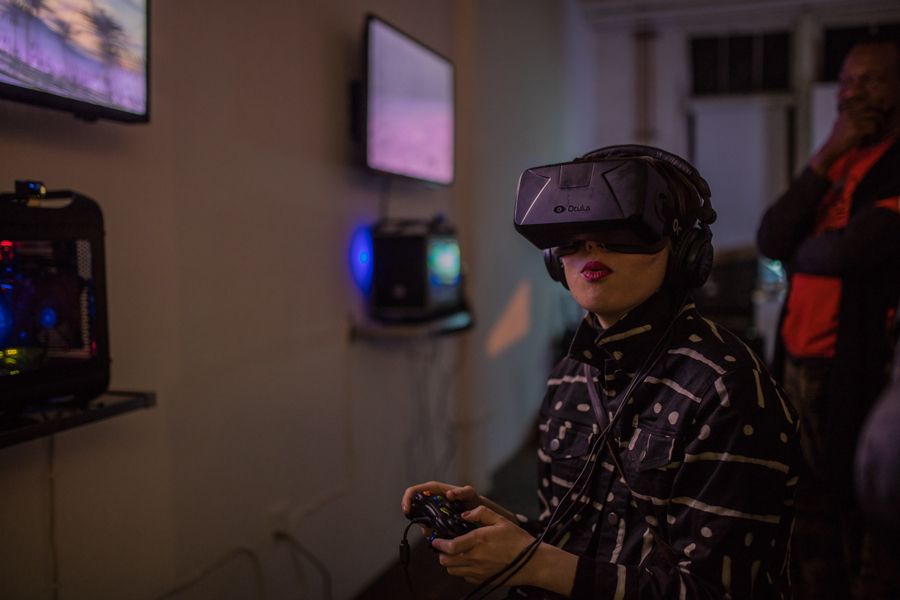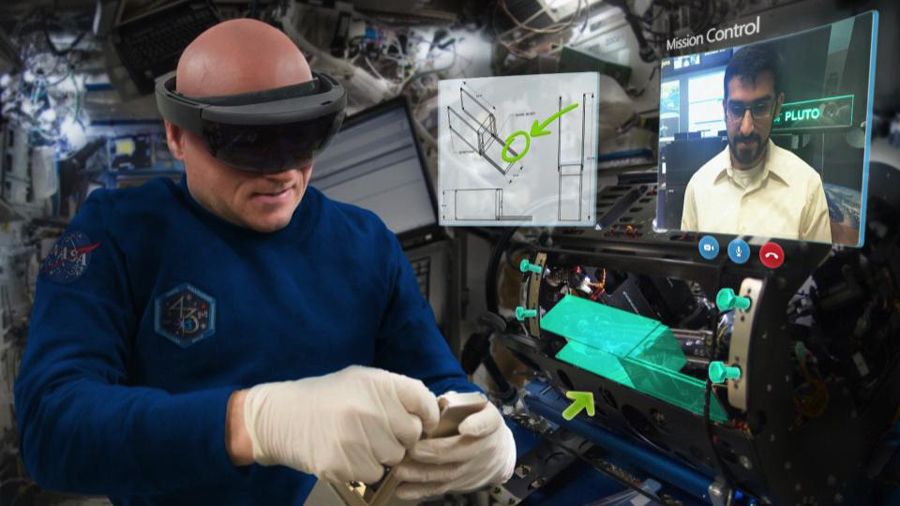A Virtual
Existence

Animation includes clips from Alfredo Salazar-Caro, Dreams of the Jaguar's Daughter, chapter 1 trailer; Sasha Samochina's RPS 3D Viewer, credit: NASA/JPL-Caltech/ProtoSpace; Claudia Hart, Welcome to the Doll's House trailer, 2020; Claudia Hart, AliceUnchained XR, 2018; Jake Elliot, Tamas Kemenczy, and Ben Babbitt, Kentucky Route Zero
by Joe Giovannetti
Virtual reality (VR) and augmented reality (AR) don’t just push boundaries—they redefine them.
They create immersive experiences, using our senses to drop us into new worlds or alter the one we know. In the wake of a booming industry—Fortune Business Insights projects a growth to $84.09 billion by 2028—more people are talking about VR and AR than ever, and School of the Art Institute of Chicago (SAIC) community members are embracing these new technologies to push the boundaries of our increasingly digital, interconnected world in unexpected ways.
Above: Photos from the Digital Museum of Digital Art
Take Alfredo Salazar-Caro (BFA 2013), a creator living and working between Mexico City, New York City, and the digital sphere. When he and fellow alum Will Robertson (BFA 2012) were taking new media classes at SAIC, they were inspired by glitch art, noise musicians, and audiovisual techniques—in short, the avant garde. However, they didn’t find their interests reflected in the traditional museum scene.
“It felt strange that there was no representation of these types of mediums within the larger scope of art exhibition,” explained Salazar-Caro, “so we decided to, as a work of institutional critique, create the Digital Museum of Digital Art.”
Co-created by Salazar-Caro and Robertson, The Digital Museum of Digital Art—abbreviated DiMoDA, with an intentional capitalization style that mirrors the Museum of Modern Art (MoMA)—is a museum dedicated to developing, exhibiting, and championing artwork in virtual reality.
Content Warning: The following video contains flashing images.
While some museums have used virtual and augmented reality techniques to bring you into or alter their physical space, DiMoDA is different; Salazar-Caro works with contemporary artists, digital or not, to create a new online universe: “For me, the more exciting thing about virtual reality and the virtual world in the first place is actually not just recreating things that already exist, but to see where artists can use their creativity to build things that have never existed before.” For each new edition of DiMoDA, he and Robertson work with architects to design a digital museum space without physical limits, which a user navigates through a VR headset.

Image courtesy of the Digital Museum of Digital Art
Image courtesy of the Digital Museum of Digital Art
The presentation of DiMoDA is driven by Salazar-Caro’s inspiration from the surrealism movement: “I always thought that it’s kind of like a mirror image of what the surrealists are trying to achieve except truly in its ultimate form … they were painting windows into these super strange worlds that came from their dreams, their imagination. And I feel like their purpose was always to try to bring us into these worlds, but they really couldn’t. With VR you actually can bring people into those places … you can just go as wild as you want.”
Above: Virtual Science Center, stills from Interview with Sasha Samochina, Deputy Manager of OPS Lab at NASA Jet Propulsion Laboratory
Alum Sasha Samochina (BFA 2009) knows all about unfamiliar worlds. She’s one of the creative technologists behind software that now helps multidisciplinary teams build spacecraft at NASA’s Jet Propulsion Laboratory (JPL).
“I first fell in love with immersive media when I created the first 360 [video] for public release on social media for NASA,” Samochina said. The project she’s most proud of is called ProtoSpace. Using augmented reality and the web, the software helps engineers work across teams to visualize spacecraft models. The software places the model in the environment, allowing the user to zoom in and zoom out, twist and manipulate it—as if the finished model were there in the room.

Image courtesy of ProtoSpace
Image courtesy of ProtoSpace
But ProtoSpace doesn’t just help aerospace engineers—the software was modified for pandemic aid. JPL’s Ventilator Intervention Technology Accessible Locally project developed models for ventilators and used ProtoSpace to teach others how to assemble their own.
Though Samochina is exploring a new career path as the director of labs for Moving Brands, she is thrilled about the lasting impact her work will have at NASA JPL. “The way that the ProtoSpace technology was and continues to be utilized, especially during a global emergency, is incredible,” explained Samochina. Her passion for using augmented reality as an educational tool is also exemplified by Reach Across the Stars, a free app that helps users meet their women space and science heroes.
“Cross reality’s most beneficial path forward is to continue contributing to making education more accessible and immersive for the next generation and making the world within reach for everyone as equally as possible,” said Samochina. “The power of showing someone your world and immersing them in it provides an incredible sense of connection and education.”
Above: Claudia Hart, still from AliceUnchained XR (walkthrough of Vive VR), 2018; still from Ludicy: A Series of Para Pandemic Liberations, 2021; still from Welcome to the Doll's House trailer, 2020
Faculty member Claudia Hart, a professor in SAIC’s Film, New Media, Video, and Animation department, embodies this philosophy. A respected voice in the digital world, Hart recently sold the first mixed reality artworks to the Whitney Museum of American Art and opened a solo exhibition at bit.art, the non-fungible token (NFT) platform of bitforms gallery. But aside from her practice, Hart is an exceptional teacher—bringing innovative virtual reality–based pedagogy to the classroom.
Hart initially developed her Experimental 3D course program in 2007, the first of its kind dedicated to teaching simulation technologies in the context of an art school. This fall semester, she’s created the newest version, titled A Bauhaus Simulism, inspired by the virtual reality platform Mozilla Hubs. In Hart’s new class, students will build their own digital environment and use it as a remote classroom. Their classroom will become an imaginary world in which students, represented by custom avatars, can interact and study new media together.

Claudia Hart. Photo: Lucy Hewett
Claudia Hart. Photo: Lucy Hewett
“This ‘Bauhaus Simulism’ is pedagogy as an imaginary world in which students play both the subject and the object of a piece of theater,” explained Hart. Using the basics of Maya 3D animation and Spoke, their classrooms will turn into real-time, live virtual reality architecture experiments.
A few years ago, Hart took a similar pedagogical approach to her Virtual Installation class, this time focusing on augmented reality. In 2015 and 2019 respectively, the classes culminated in The Romantic App and The Romantic App 2.0, group projects that superimposed moving-image artworks over the painting collection at the Art Institute of Chicago museum.

Students engaging with The Romantic App. Photo: Lucy Hewett
Students engaging with The Romantic App. Photo: Lucy Hewett
“We thought of our augmented reality app [as if it were] installed on the smartphone of a normal museum visitor,” said Hart. “They were ‘magic mirrors,’ ... peeked through by the public as they strolled through the museum.” As an extension of the project, students performed museum tours of their collections as if they were university lecturers themselves.
Hart’s new media courses are rooted in an approach that’s centered on creativity and disruption, as opposed to commercial effects training. However, when you hear virtual reality, you probably think about video games—an industry where it’s becoming increasingly popular to use immersive technologies, thanks to products like Oculus headsets that have helped turn traditional gaming into truly artistic experiences.
Above: Jake Elliot, Tamas Kemenczy, and Ben Babbitt (Cardboard Computer), still from Kentucky Route Zero; still from The Entertainment
“Art history is full of games-as-art and art-as-game,” said alum Jake Elliot (BFA 2011) alongside Tamas Kemenczy (BFA 2007) and musician Ben Babbitt (BFA 2013). In the video game industry, this trio is best known as the creators of the popular video game Kentucky Route Zero, which is critically acclaimed and has been the recipient of many awards, including the British Academy of Film and Television Arts 2021 award for original property; as a testament to its creative prowess, it was even featured in an exhibition called Videogames: Design/Play/Disrupt curated by Marie Foulston at the Victoria & Albert Museum in London.
As students at SAIC, Elliot, Kemenczy, and Babbitt gained exposure to virtual reality through the Cave Automatic Virtual Environment system (often simply referred to as CAVE); in 2013, they used their knowledge to experiment with a free game titled The Entertainment, an “interlude” between episodes of Kentucky Route Zero.
The Entertainment gameplay
The Entertainment gameplay
“In this interlude, you're watching a stage play in first-person, from the perspective of an actor on stage who has no spoken lines,” explained Elliot. “Using the headset by itself, without a controller, the only way the player can interact is by looking around. So we based our design on this interaction. The play is mostly centered around a couple of overlapping arguments in a rural tavern over the course of a summer day, just drinking and eavesdropping.” The team designed and programmed the game for an early development version of the Oculus Rift headset and showed it at Wordplay, a games festival in Toronto.
Whether it’s through video games, new museum experiences, experimental technology, or inside a classroom at SAIC, our alums and faculty show that virtual and augmented reality have the potential to push the art industry to new heights—and perhaps, one day, help make it even more accessible.
“I think making more museums accessible to everyone virtually will allow those that may think that art is not for them to feel more comfortable and more curious with the museum space, making the in-person experience that much more incredible,” shared Samochina.
And for Salazar-Caro, the potential of virtual and augmented reality boils down to just one word: “limitless.” ■

